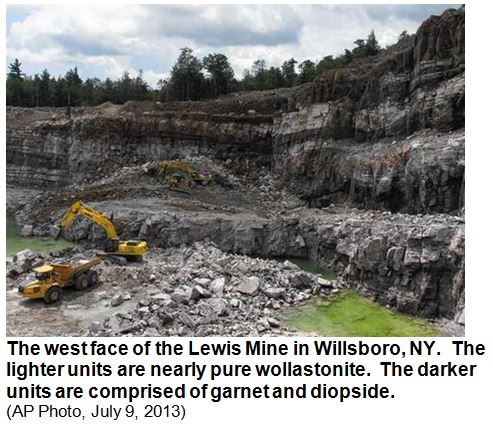Article I published in March, 2014 WCGMC News
Mineral collectors appreciate the golden amber grossular garnet and green diopside offset by the brilliant white of the matrix wollastonite. Students of SUNY-Plattsburg learn about contact metamorphism from Dr. Mary Roden-Tice during field trips to the locale. Economic geologists appreciate the mine as one of only two active wollastonite producing mines in the United States, both of which are in New York State (the Valentine Mine near Harrisville is the second). But to many New Yorkers, the Lewis Mine of Willsboro Township in Essex County, New York went about its annual production of about 60,000 tons of wollastonite (~10% of the world’s production) in quiet anonymity.
But in November of 2013, all New York State residents who voted in the state election learned about the Lewis Mine in Essex County when they considered Proposition #5 on their ballots. In that proposition, the mine’s operator sought permission to conduct exploratory drilling on a 200-acre parcel of land adjacent to their active mine, land that had been previously incorporated into the Adirondack Preserve. In exchange the state would get funds to add as much as 1500 acres of other forest land to the preserve. The proposition passed with a 52.3% majority of New York state voters supporting the initiative, although the state has yet to rule on the request and the details remain to be negotiated.
An aerial view of the current mine development defines the issue. The Lewis Mine has followed the wollastonite-rich seam as far as the current land position will allow creating a sharp north-south demarcation between the western pit wall and the Adirondack Preserve. NYCO claims that without permission to explore, and ultimately mine, into the western 200 acre parcel, the mine’s life is probably about 3-5 years. They estimate an additional decade of life to the reserves if allowed to extend the mine to the west. NYCO is committed to restore the region at the conclusion of the mine’s viability.
The wollastonite occurs within a contact zone with the majestic anorthosite massif that dominates the central highlands of the Adirondacks. At the mine, the anorthosite is overlain by a thin mafic gneiss which is in turn overlain by the wollastonite ore. The ore consists of only three minerals: wollastonite, grandite garnet, and diopside. Grandite garnet is a term used for the solid solution between grossular and andradite. Often the red-amber grandite garnet is colorfully intergrown with white wollastonite (see cover photo). The mineralogy and setting clearly indicate a contact metamorphic origin, where the siliceous carbonates were “cooked” to temperatures at or above 400-450°C by the adjacent anorthosite intrusion.
Pure wollastonite (CaSiO3) is bright white, but impurities like iron, magnesium, potassium, sodium, aluminum and other elements can impart a cream, grey, green or even brown color. The wollastonite mined at both the Lewis Mine and the Valentine Mine is very pure and thus very white which adds to its utility and value. During crushing, wollastonite breaks into lath- or needle-shaped acicular particles parallel to its cleavage surfaces. This acicular character makes it an excellent reinforcement material when added to plastics, paint films, and ceramics. The wollastonite in plastics and ceramics serves much the same purpose that steel rods do in concrete.
In addition, wollastonite is used as a replacement for asbestos in products like insulation, paint, roofing tiles, and it is gaining use in friction devices such as brakes and clutches. It is a very popular additive to a host of ceramic products as it helps to reduce warping and cracking during firing and can provide added strength to the end product. It is used as a flux in steel making, and as a hardening and reinforcement agent in paints. When wollastonite is added to stucco-type products the resulting surface is not only brighter and more attractive, but also more resistant to cracking and weathering.
References:
Valley, J.W., and Essene, E.J., 1980, Calc-silicate reactions in Adirondack marbles: the role of fluids and solid solutions, GSA Bulletin, Part I p. 114-117, part II, p. 720-815.
Vitre, R. L., and Van Gosen, B.S., undated, Wollastonite – A Versatile Industrial Mineral, USGS Information brochure various New York State daily newspaper reports of the past several months


